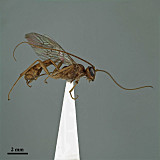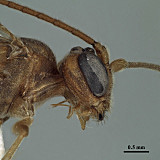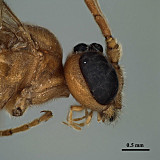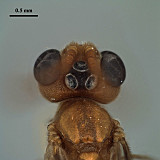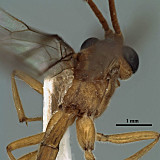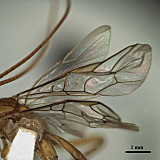Mesosoma 2.2 mm; fore wing 5.8-5.9 mm. Antenna with 52 (female) and 46 [46-47 in original description] (male) flagellomeres. Frons coarsely granular, abruptly transitioning posteriorly at anterior margin of lateral ocellus to punctate, the punctures separated by about their diameter. Eye large, in lateral view 1.6 (female) and 2.0 (male) x longer than temple (Figs 2, 3). Ocelli exceptionally enlarged, maximum diameter of lateral ocellus 1.75 (female) and 3.55 (male) x distance from lateral ocellus to eye (male: Fig. 4); ocellar triangle 3.6 (female) and 6.9 (male) x wider than shortest distance between lateral ocellus and eye. Malar space barely indicated in female. Epomia well-developed, vertical. Mesoscutum punctate, punctures separated by about their own diameter laterally, becoming larger and denser posteromedially; notaulus weakly indicated on anterior declivity. Propodeal carinae nearly complete (Fig. 5): areola narrowing posteriorly, confluent with basal area anteriorly (basal transverse carina absent or very weak medially); propodeum rugulose medially, second lateral area weakly punctate in male, more heavily and densely punctate in female. Fore wing Rs+2r arising distinctly distad mid stigma, from about apical 0.4; M+Cu with spurious vein (Fig. 6) extending into basal cell more than half distance to anterior margin, bent or curved distally in its anterior 0.25-0.3, spurious vein distant from 1M by about 1.4 x length of 1cu-a; 1cu-a distinctly postfurcal; 1M weakly sinuate, nearly vertical for most of its length, slightly curving distally into parastigma; m-cu parallel to 1M basally, evenly curving distally; basal cell largely bare on either side of spurious vein. Hind wing cu-a long to very long, 3.5 (female) and 10.4 (male) x longer than 1st abscissa of Cu1. Metasoma with T1 length from spiracle to base 2.1-2.2 x longer than width at spiracles 4.0-4.2 x longer than minimum width, width at spiracle 1.9 x minimum width. Color: yellow-orange, including all flagellomeres, except ocellar field dark, mandibular teeth dark red; wings very faintly infumate.
This description and the associated images are based primarily on a male and female from Gambia in BMNH. The male matches the original description and notes on Benoit’s holotype (RMCA).
2.
Head, lateral view, fema...
Head, lateral view, female
↰
↴
3.
Head, lateral view, male...
Head, lateral view, male
↰
↴
4.Head, dorsal view, male

